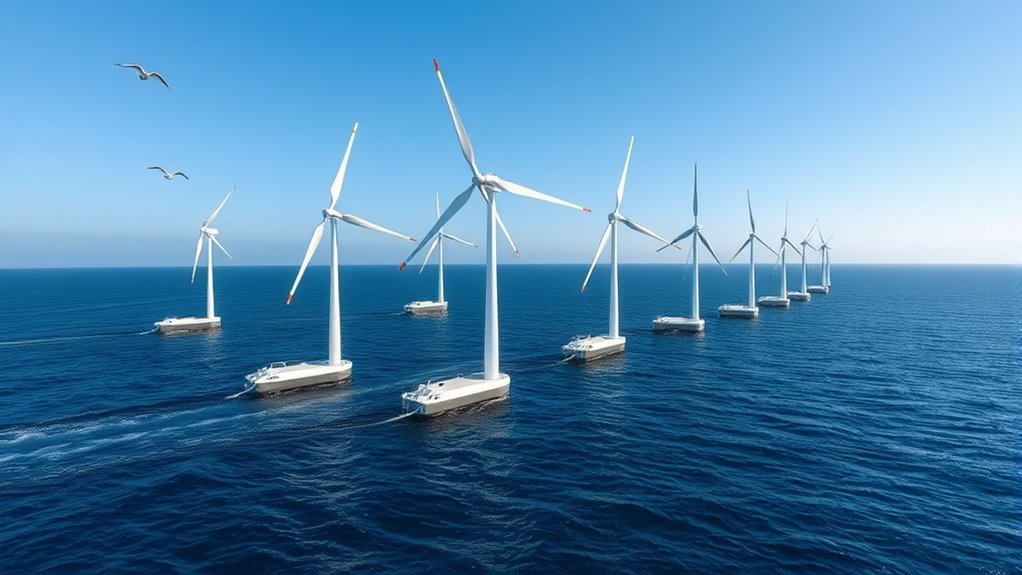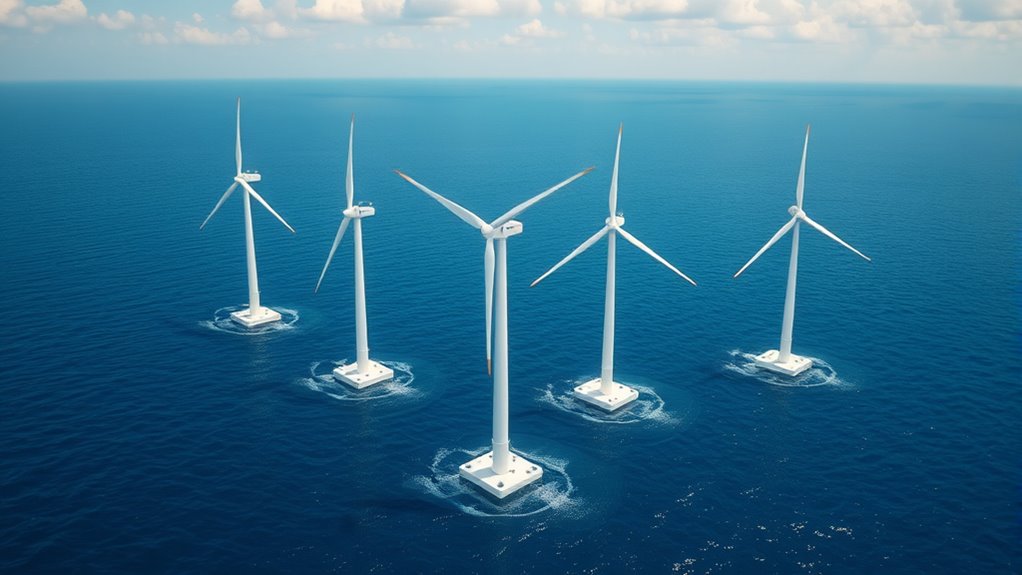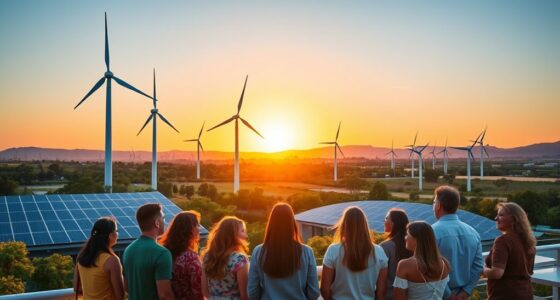Floating offshore wind turbines tap into the deep ocean’s powerful, consistent winds by using innovative floating platforms anchored to the seabed. This allows you to harness energy far beyond shallow waters, expanding renewable options into vast, previously inaccessible ocean areas. While the technology offers major environmental and economic advantages, it also involves navigation challenges and maintenance complexities. If you’re curious about how these systems work and their future potential, there’s plenty more to explore.
Key Takeaways
- Floating offshore wind turbines enable energy generation in deep waters beyond traditional shallow coastal areas.
- They access stronger, more consistent offshore winds for higher electricity output.
- Proper environmental planning minimizes impacts on marine ecosystems and migratory routes.
- Maintenance challenges are addressed through innovations like remote monitoring and specialized vessels.
- Advancements in technology and sustainable management expand deep ocean renewable energy potential.

Have you ever wondered how wind turbines can harness energy far from the coast? Floating offshore wind turbines make that possible by allowing energy generation in deep waters where traditional fixed-foundation turbines can’t operate. These turbines are anchored to the seabed with mooring lines and floating platforms, enabling access to stronger, more consistent winds found offshore. This technology opens a new frontier for renewable energy, tapping into vast ocean areas that were previously unreachable. As you consider the advantages, it’s clear floating turbines can generate significant power without the constraints of shallow waters, making them ideal for countries with deep coastal regions.
Floating offshore wind turbines harness energy in deep waters, unlocking vast, previously unreachable ocean areas for renewable power.
However, deploying these turbines isn’t without its challenges. One vital aspect is understanding their impact on the marine habitat. Floating turbines are situated in areas rich with marine life, so careful planning is essential to minimize disruption. During installation and operation, noise and physical presence can disturb marine species, but ongoing research and environmental assessments help mitigate these effects. Proper siting ensures these turbines coexist with local ecosystems, protecting migratory routes and breeding grounds. Additionally, the floating platforms are designed to be stable and resilient, reducing the risk of accidents that could harm marine animals or pollute the environment.
Another key consideration is turbine maintenance. Unlike land-based or fixed offshore turbines, floating turbines are exposed to harsher conditions, including stronger waves, currents, and storms. This makes maintenance more complex and costly but also more vital for reliability and longevity. Accessing these turbines often requires specialized vessels and equipment, especially in rough weather, which can delay repairs and inspections. Innovations in remote monitoring and automation are helping to streamline turbine maintenance, allowing technicians to identify issues early and perform repairs more efficiently. Regular upkeep ensures the turbines operate at peak performance, minimizing downtime and maximizing energy output.
Furthermore, advancements in vertical storage solutions can assist in managing the intermittent nature of wind energy, providing a more stable power supply. Ultimately, floating offshore wind turbines represent a promising step toward sustainable energy, but they demand careful environmental and operational planning. By understanding their impact on the marine habitat and investing in advanced maintenance techniques, you can help guarantee these turbines deliver clean power while protecting ocean ecosystems. As technology evolves, managing these factors effectively will be key to expanding offshore wind capacity and harnessing the vast power of the deep ocean efficiently and responsibly.
Frequently Asked Questions
What Are the Environmental Impacts of Floating Offshore Wind Farms?
You might wonder about the environmental impacts of floating offshore wind farms. They can affect marine biodiversity by disrupting habitats and migration patterns. Noise pollution from construction and operation can disturb marine life, especially mammals. However, compared to other energy sources, floating wind farms tend to have a lower overall environmental footprint, offering a cleaner alternative. Proper planning and technology can minimize these impacts, making them a sustainable energy option.
How Do Floating Turbines Withstand Harsh Ocean Conditions?
You might think harsh ocean conditions would topple floating turbines, but they’re built tough. Their mooring systems anchor them securely, even in fierce storms. Wave resilience is key, as engineers design these turbines to flex and bend with the waves, not break. This combination of strong mooring and adaptable design guarantees they withstand relentless ocean forces, proving that innovation can conquer nature’s might and harness clean energy from the deep.
What Are the Costs Compared to Traditional Offshore Turbines?
You’ll find that the cost comparison between floating offshore wind turbines and traditional fixed-bottom turbines shows higher initial expenses for floating options. However, their economic viability improves in deeper waters where fixed turbines aren’t feasible. While construction and maintenance costs are greater, floating turbines reveal new sites, potentially leading to more consistent energy production and long-term savings, making them a promising investment for expanding renewable energy.
How Is the Energy Transmitted From Floating Turbines to Land?
Imagine the thrill of power transmission from ocean’s depths to your home. You see, floating turbines generate electricity that’s sent via subsea cables—specialized, underwater conduits—directly to land. These subsea cables are designed to withstand harsh conditions, ensuring reliable power transfer. As the electricity travels through these cables, it’s seamlessly integrated into the grid, bringing clean energy from the deep sea straight to your doorstep.
What Future Technological Advancements Are Expected in This Field?
You can expect future advancements in floating offshore wind turbines to include innovative mooring systems that improve stability and reduce costs. Additionally, turbine scalability will likely increase, allowing for larger, more efficient turbines that generate more power. These technological improvements will make offshore wind energy more reliable and accessible, helping to expand renewable energy production and reduce reliance on fossil fuels.
Conclusion
So, there you have it—floating offshore wind turbines, the ocean’s latest attempt at being your energy hero. Who knew giant turbines bobbing on waves could save the planet while giving us sea-sick dreams? With all the floating marvels, maybe soon we’ll have fish as the new power grid and dolphins as energy consultants. Until then, sit back, relax, and enjoy the show — the future of clean energy is just a boat ride away.










